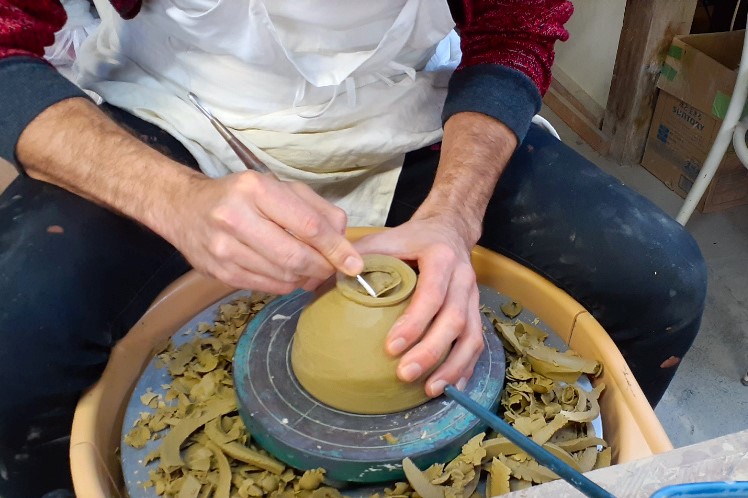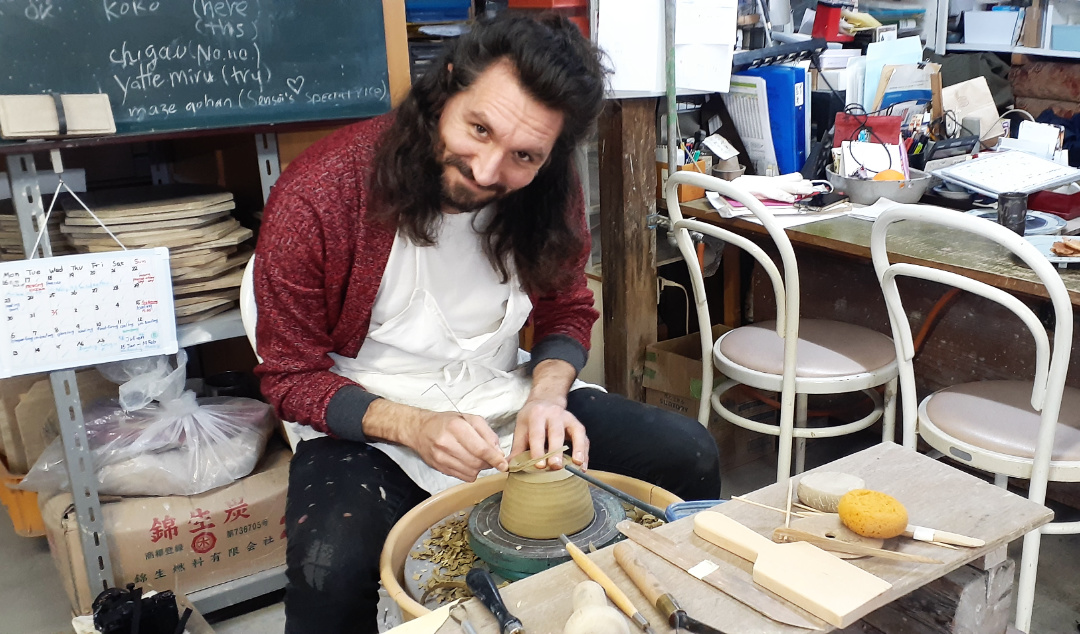多治見に訪れた人たち、そしてその後 ~日本語と英語でご紹介~
外国人観光客が感じた多治見の魅力
IMPRESSIONS OF AUTHENTIC JAPAN
このサイトDiscoverTajimi.comは開設してから6年経ち、ネット上で多治見に関する検索が多くたどり着く場所として成熟してきました。今でも何年も前に公開した記事を探し当て、たくさんの方がこのサイトに訪れてくれるので僕たちの励みになっています。今回はそんな記事にフォーカスしたいと思います。その記事は2018年にアップしたもので、この地域のお正月の習慣での自然薯の役割について書きました。
This site, Discovertajimi.com, has been running for a few years now and has matured into a place many Google searches about Japan end up. It’s always encouraging to see how people find articles that were published years ago, and one such piece dates back to 2018, when we wrote about the Japanese wild yam and its role in the New Year’s celebrations.
ドイツ人自然薯起業家のニコライさん
NICOLAI, THE GERMAN YAM ENTREPRENEUR
2022年11月23日、ドイツのニコライ・シュミットさんから多治見への訪問についてこんな問い合わせがありました。
「私は28歳で長芋の研究をしています。長芋の栽培について勉強するため、今青森に来ています。特に無農薬・無化学肥料の有機栽培の農家を探しているのですが、その中で自然薯について知って、どうしても見てみたいと思っています。ハンス・カールソンさんの記事によると、多治見周辺の山に自生しているそうですね。私はドイツでは数少ない長芋の有機栽培農業家ですので、日本でできるだけ多くのことを学びたいと思っています」
On November 23, 2022, Mr. Nicolai Schmidt from Germany wrote to us to inquire about a visit to Tajimi:
“I am 28 years old and doing a research project about Japanese yam. Now I am in Aomori, where I am learning about nagaimo cultivation. I am especially searching for organic farms that do not use mineral fertilizers and pesticides. However, I am also looking for jinenjo (wild yam). According to Hans Karlsson’s article, it grows in the mountains surrounding Tajimi. I would really like to see it there or even join in digging it out. “I am also one of the very few biodynamic nagaimo cultivators in Germany, and I want to learn as much as I can about it here in Japan.”
イモは「芋」、ナガイは「長い」を意味し、ナガイモは特に長い種類のイモの名称となっています。自然薯は長芋と同じくヤマノイモ科の植物です。食物繊維やミネラル、抗酸化物質など多くの健康成分を含んでおり、まさにご馳走と呼ぶに相応しい食材です。地中深くに生息しているため、見つけるのも掘り出すのも一苦労なんです。
Imo is the Japanese word for “potato,” and nagai is “long,” so the word nagaimo is the name for a particularly long species of potato. Jinenjo , or Japanese mountain yam (the botanical name is Dioscorea japonica), on the other hand, is its wild cousin. It is regarded as a real treat; it is packed with many healthy qualities such as fiber, minerals, and antioxidants. It lives deep underground and requires a lot of work to find and dig out.
ニコライさんが地元の食材に興味を持ってくれていて、僕たちはとてもうれしく感じました。どうやら彼は芋オタクのようですね。知り合いにいろいろと話を聞いているうちに、地元のその分野の専門知識を持った「自然薯名人」とも呼ぶべき人を探し出すことができました。自然薯名人は、山に生える植物や木などを知り尽くしているそうですが、外国人を山に案内するのは初めてのことでした。彼は英語も分からずコミュニケーションが不安だということで、僕たちは2人の冒険を記録させてもらうのと引き換えに協力することを約束し、付いていくことになったのです。
We were quite pleased that Nicolai showed such interest in this local delicacy. He would, in fact, turn out to be a real potato nerd. After some asking around, we were able to locate a local “meijin,” or “famous man,” a person with expert knowledge in a certain field. He was said to have deep insights into things you can find in the mountains, such as valuable plants, wood, and so forth. We were told that he made his living by selling such items to local buyers, but that he was also shy and unsure about guiding a foreigner up in the mountains. That he didn’t speak a word of English didn’t help either. So, we promised to help out and document the two men’s adventure.
ニコライさんは滞在している宿泊施設から自転車を借りて僕たちのところにやってくるということでしたが、土地勘がないので道に迷わないか僕たちはちょっと心配していました。その当日は朝早く、かなり冷え込んだ日でした。防寒着を着込んで家を出て約束の場所に行くと、背の高い細身の外国人が、いかにも「山歩き名人」という見かけの日本人と立ち話をしているのに気づきました。しかし事前情報では、その名人は英語ができないはずでは……。僕たちはかなり面食らいましたが、その二人はまさに僕たちと約束をした人たちであり、お互いに一言も理解できないのに、とても仲良くしていたのです!!話を聞くと名人は、多分この外国人だろうと思ってコンビニでコーヒーを買ってきて、楽しく一緒に飲んでいたということでした。
Nicolai was apparently staying in a lodge in another village, and we were told he would arrive at our house by bicycle. We were a bit worried about whether he would find his way. We were to set out early in the morning, and it was quite chilly. We put on our warm clothes, stepped out of the house, and crossed the street to the parking lot on the other side when we noticed a very tall, slim foreigner was standing there chatting with a Japanese man who looked like a “meijin” indeed. But that person was not supposed to be able to speak English. We were quite confused. It turned out both men were exactly the people we were to assist, and they were getting along very well, although they didn’t understand one word of what they were saying to each other. The meijin had bought coffee for the guest at the convenience store, and they were having a good time.
ニコライさんはとても感じのいい人で、イモに対してとても真摯に向き合っており、かなり詳しいことが分かりました。昔ドイツに自然薯に似たナガイモが持ち込まれ、ヨーロッパではまだ珍しいそうですが栽培できるようになったと話してくれました。そして今回、日本の自然薯をドイツで商業的に、しかもオーガニックで自然な方法で栽培できないかと考えたのだそうです。自然薯名人の話によると、日本では、通常 人工栽培では斜めに埋めたビニールパイプに自然薯を入れ、下に垂直に伸びないようにするのだそうです。自然薯は自然の本能として非常に深く成長するのですが、それができない場合より速く、より大きく成長するのだと話してくれました。しかしニコライさんは自然のままに成長させ、なおかつ商売になるよう効率的に作物を栽培するアイデアがあるようでした。
Nicolai turned out to be a very nice guy and very serious and knowledgeable about potatoes. He told us that a similar kind of potato to the jinenjo had been brought back to Germany a very long time ago and that people were able to grow it in Europe, although it was still very rare. Now he wanted to bring the Japanese wild yam to Germany to try and see if it could be grown commercially and in an organic and natural way. The meijin told us that in Japan, normally commercial growers put the jinenjo in a vertical plastic pipe to stop it from growing downward. It is the natural “instinct” of the wild yam to grow very deep, and when it can’t, it grows faster and bigger. However, Nicolai had an idea to let it grow the natural way and still be able to grow crops efficiently enough to sustain a business.
そうして僕たちは、貴重な自然薯を探すために山に入っていきました。そこは竹やぶが生い茂り、地面の草木に足を取られて転びそうになるような場所です。しか名人はスパイク付きのブーツをはいて驚くほど速く、迷うことなく素早く進んでいきます。僕は彼の健脚には全然かないませんでした。
Soon we were up in the mountains looking for the valuable potatoes, and I began to realise this was going to be a challenge. The bamboo groves were very thick, and vegetation on the ground kept trying to snare my feet and make me fall. The meijin was incredibly quick, however, and moved fast and without hesitation in his spiked boots. I had trouble keeping up.

やがて名人は何かを見つけたようで、必死に地面を掘り始め、どんどん深く掘り進んでいきました。彼は自然薯が育つ土がとても重要なのだと、掘りながら説明してくれました。赤くて鉄分を含んでいないといい芋の味は出ません。それに外の皮をきれいに剥いてしまってはいけないのです。「土の風味が少し残っていると、とてもいい味になるんだよ。」と彼は教えてくれました。よその地域の人にはそれがわからず、自然薯を丁寧に洗って皮を剥いてしまう人が多く、しばしば地元の人たちの笑い話になるなんてことも話しました。
Soon the expert seemed to have found something and started digging frantically in the ground, deeper and deeper. In fact, the earth where the yam grows is very important, as the meijin explained as we dug deeper. It needs to be red and contain iron for the root to taste as it should. And you mustn’t wash all of it off. “A little bit of earth adds to the taste in a very nice way.” He told us that people from other tracts don’t understand this, and when they wash the root carefully, it makes local folks laugh.

名人は自然薯を長いまま折らないように掘りあげようとしましたが、残念ながら途中で折れてしまいました。それでは商品としては価値が下がるそうですが、個人で食べる分には問題ありません。どんどん山の中に進んで、ジャングルのように植物が生い茂って、通り抜けるのにナタが必要なさらに太い木立の奥に入っていきました。そのころにはニコライさんは立派な自然薯ハンターになっていました。自然薯のツルは高さ4メートルにもなるような木などに登っているのです。生い茂る草木の中を高速で移動するニコライさんの姿は、まさに本領発揮といった感じでした。
The meijin managed to get the first long “tuber,” as they are called, up, but it broke in the process. That would ruin it as a product, but for private consumption, it’s fine. We carried on and got into even thicker groves, like a jungle where you need a machete. Nicolai turned out to be a great jinenjo hunter. The vines can grow up to 4 metres tall and climb on trees and other structures. He looked like he was in his natural element, moving fast through the thick vegetation.

夜は自然薯料理で大満足の食事でした。なんと名人を紹介してくれた人の奥さんが、掘ってきた自然薯を快く料理してくれたのです。ニコライさんはとても嬉しそうでした。たった1日しか一緒にいませんでしたが、自然薯掘りや夜の宴会は鮮やかな記憶として僕の中に残っています。ニコライさんはドイツでこの植物を育てる計画があるそうですが、その後どうなったのだろうかと思いを馳せていました。そんな折、それに関するお知らせがヨーロッパから届きました。この記事の最後に付け足しておきましたよ。
In the evening, we had a great meal, feasting on the jinenjo. Nicolai looked very happy. The wife of the man who had introduced us to the meijin had graciously prepared the jinenjo for us, and now we were in for a real treat. Despite the fact that we only spent one day together, the digging in the mountains and the party at the end have stayed with me as vivid memories. I know Nicolai has plans to grow this plant in Germany, and I often wonder how that went. As we’ll see, we got some news from Europe on that.
HO-CAの工房で陶芸を学ぶ学生たち
POTTERY STUDENTS AT THE HO-CA STUDIO

2023年2月18日、僕は多治見の中でも特に好きな場所であるHo-Caの陶芸工房を再び訪れました。少し雑然としていますが、それがさらに人間味を醸し出したとても温かく居心地のいい工房で、陶芸家の柴田節郎さんが弟子たちを指導しています。僕は彼のことを日ごろから粘土の魔法を操る日本のガンダルフのような方だと思っているのですよ。この日は、アメリカのペンシルベニア州から来たマーサさんが工房にやってきました。彼女は多治見市の近隣の瑞浪市に数日滞在し、ボランティアでブドウ畑や純米酒畑で農作業をしてきたそうです。コンピューターサイエンスが彼女の専門ですが、アートにも強い関心を持っているようです。今彼女はリラックスした環境の中で、自分のもう一つの側面を探求する時間を持ちたいと話してくれました。ここはそんな彼女にぴったりの場所だと思いました。
On February 18, 2023, I visited the Ho-Ca pottery studio again, one of my favourite places to visit in all of Tajimi. You always feel at home when you step into the slightly untidy but very warm and cosy studio where pottery master Setsuro Shibata teaches his students. He resembles a Japanese Gandalf wielding his clay magic. On the day of my visit, the studio had a new arrival, Martha from Pennsylvania, USA. She’d recently arrived in Japan for a two-month stay, and after some sightseeing, she’d spent a few days in Mizunami, a neighbouring city to Tajimi, where she’d worked as a volunteer farm hand in the vineyards and jinenjo fields—there was already a connection to Nicolai! Martha has a background in computer science but a strong interest in art as well; now she wanted to spend time exploring that other side of herself in a relaxed setting. I thought she had probably found just the right place.
僕が工房を訪れた時には、マーサさんのほかにフランス出身でスイスを拠点に家具やインテリアのデザインをしているジュリアンさんに、新潟出身で東京の美術大学に通っているキョウコさんもいました。シンガポールから来たリンダさんは、Ho-caでの長期作陶コースを終えたばかりでしたが、11月にまた来る予定だということです。工房は今とても忙しく、メールボックスには問い合わせが続々と届いています。そんな様子から僕はコロナパンデミック後の観光規制が解除されたことを強く実感しています。
There were also Julian from France, a furniture and interior designer based in Switzerland, and Kyoko from Niigata in northern Japan, who is currently studying at a university in Tokyo. Linda from Singapore had just finished her course but is planning to come back in November. The studio is very busy now; inquiries are landing in our mailbox in a steady stream. You can feel that the pandemic restrictions on tourism have been lifted.

生徒たちに感想を聞いてみました。マーサさんは、これまでHo-Caで出会った生徒と同様、とても熱心な生徒のようです。印象的だったのは、彼女がすでに日本語を少し勉強していたことです。もし読者の皆さんもこの国を旅行する予定があるなら、ぜひ勉強しておくことをお勧めします。日本人はほとんどモノリンガル(日本語だけ)なので、あなたが日本語の単語をたった数個知っているだけでも、あなたの経験をより豊かなものにする助けになるでしょう。幸いなことに柴田先生はコミュニケーション能力に長けていて、黒板には教えるのに役立つ単語が書き込まれています。ここには言葉の壁で行き詰まる人はいないようですね。
I asked the students about their impressions. Martha looked like a very dedicated student, like the others I have met at Ho-Ca. Impressively, she had already picked up some Japanese, which I would really recommend you do if you plan to travel here. The Japanese are largely monolingual, and even a few words will go miles to improve your experience. Luckily, Shibata-sensei is a great communicator and uses a blackboard where the most useful words for instructions are scribbled. No one seems to be stuck because of the language barrier here.
前から滞在中のジュリアンさんは「ここでの勉強にとても満足しています!学んだことを活かして、本業のデザイナーの仕事に取り入れたいんです」と話してくれました。確かに彼の作る家具やインテリアのモダンでシャープな印象と、日本的な陶器のオーガニックな感覚とのバランスは、とても魅力的なアイデアだと思います。そして「言葉や文化が障壁になることもありますが、とにかくその中に飛び込んで集中することが大事ですよね。それからこの場所の本物らしさが好きです。リアルさを感じるのです。ここにはいろいろなものがあり、ふとすると散らかっているようにも見えますが、歩き回ってあらゆるものを勉強し学ぶことができます。もっと時間があればいいのに!」とたくさん語ってくれました。ジュリアンさんはすでに2週間滞在を延長しているにもかかわらず、まだ時間が足りないと感じているようです。
“I am very satisfied with my study experience here,” says Julian. I want to use what I’ve learned and incorporate it into my work as a professional designer. Indeed, balancing the modernistic and sharp look of his furniture and interiors with the organic feel of Japanese-style pottery seems like a very appealing idea. “Language and culture can be a barrier,” he says, “but you just need to dive in and focus. And I love the authenticity of this place; it feels real. With all the things and clutter in here, you can walk around and study all the things and learn.” “I only wish I had more time!” Even though Julian has already extended his stay by two weeks, he still feels that there is not enough time.

キョウコさんにも聞いてみたらとても満足そうに話してくれました。「私の大学のスタディーサークルでは、このような指導を受ける機会はないんです。それにガス窯はなく、電気窯だけしかないんです。滞在中は朝6時に起きて、1時間かけて町の中を散歩しています。先週末は市の中心部のオリベストリートに行って、素敵な陶器を見て、道具を買って、おいしいものをたくさん食べました。とても楽しかったです。ここでは陶芸だけでなく、英語もたくさん学べますしね」
Kyoko seems very happy too. “We have no chance to get this kind of guidance in the study circle in my school,” she says. “And we have no gas kiln, just an electric one. I get up at 6 in the morning and take an hour-long walk around the village. Last weekend, I went downtown to Oribe Street, looked at all the great pottery, bought some tools, and had lots of good food. I had so much fun! I also enjoy being here with foreign students; I learn a lot of English, not just pottery.
このように長い時間、一つのことに集中できる環境は、慌ただしい現代社会ではなかなかありません。私はマーサさんに「無」という言葉を教えてあげました。「無」とは、精神的に空っぽの状態になることで、周囲の雑念から完全に切り離されることです。「無」は、禅の思想における重要な用語です。この言葉は日常的な日本語でも使われ、「何もない世界に漂う」というような意味を持ちます。例えばろくろの上の粘土に集中していると、このようなことが起こります。
それを聞いてマーサさんはこう言いました。「粘土に支配されたり、思い通りの形にされたりするのではなく、自分の頭の中で想像したとおりの形にしたいんです。」それを聞いて僕は、はおそらく粘土と戦うのではなく、無の世界で粘土と一体になることが、それを達成する一つの方法なのではないかなと感じました。
Being able to focus on a craft for an extended period of time like this is rare in today’s hectic society. I tell Martha about Mu, the Japanese word for an empty space you enter mentally, completely disconnecting yourself from the distractions of the surrounding world. Mu is a key term in the philosophy of Zen Buddhism. The word is used in everyday Japanese as well, meaning something like “drifting off into a world of empty space.” This can happen when you are completely focused on the clay on the potter’s wheel, for example.
Martha put it very well: “I want to make the clay shape as I imagine it in my mind, not have it take over and take the shape it wants.” Perhaps, I think, one way to accomplish that is not to fight the clay but to become one with it in the world of nothingness.
帰国後
COMING HOME
熱心な訪問者たちは帰国してそこで感じたことを消化し、今後の仕事や趣味に活かしているようです。先出の山芋起業家のニコライさんからはドイツに帰国した後の様子をメールで伝えてくれました。
These dedicated students have yet to return home to digest their impressions and put them to use in their future work or hobbies. Nicolai, the Jinenjo entrepreneur, however, just wrote back to tell us what happened after his return to Germany.
「私は今、バーゼル大学でゲーテアヌムと共同で、長芋の研究プロジェクトを続けています。これは1850年代の晩枯病(※)によるジャガイモの不作時に、ドイツでナガイモを栽培しようという話が持ち上がったのが最初です。その時は何度か試験栽培が行われたが、収穫に手間がかかるためか継続されませんでした。
私はドイツの有機栽培農場でナガイモの栽培を行い、伝統的にジャガイモを食べるドイツ人の皆さんに、私が考案した基本レシピで料理したナガイモを紹介しました。みんな本当に喜んで食べてくれました。多治見で教えてもらったヌルヌルした生の食べ方は万人に好まれるものではありませんが、中にはとても喜んでくれる人もいます。ドイツではナガイモはとても高価です(1キロあたり約25〜40ユーロ)。それは収穫するのに非常に多くの手作業が必要だからです。
さらにほとんどの土壌が自然薯に適していないため、溝を作る必要があるのです。栽培を楽にするために、私はドイツの土壌の異なる場所で試験栽培を行っています。適切な自然の土壌を見つけたいのです。そして日本ではナガイモの収穫機を知ることができました。ドイツでこの機械を導入することは大きなステップになると思いますが、まずはこの植物が食用として普及し、土壌のよい農家で栽培したいという人が増えることが必要ですね。
そこで私はプロジェクトの第一弾として、さまざまな植物の形を比較研究することで、植物を理解しようと試みています。そのプロジェクトで、バーゼル大学(スイス)に来ることになり、同じバーゼル近郊のゲーテアヌムと共同研究をしているのです」
※ 晩枯病は、トマトやジャガイモの葉、茎、トマトの果実、ジャガイモの塊茎に感染し、致命的な被害をもたらす可能性のある病気。
“I am now continuing my Nagaimo research project at the University of Basel in collaboration with the Goetheanum. During the bad potato harvests caused by late blight disease (※) in the 1850s, the idea of cultivating Chinese yam (nagaimo) in Germany first arose. There were some trials, but probably it was too much work to harvest, so they did not continue.
I developed a nagaimo culture at a biodynamic farm in Germany and introduced the nagaimo to traditional German potato eaters at the market using a basic recipe I devised. Everyone really enjoyed it. The Japanese way of eating it, slimy and raw, is not preferred by everyone, but there are some who appreciate it a lot. In Germany, the Nagaimo is very expensive (approximately € 25-40 per kilo). That is because it requires so much manual labour to harvest it.
Furthermore, we need to make a ditch because most soils are not appropriate for the jinenjo. To make the growing process easier, I am doing some trials in Germany at different sites with different soils. I want to find a natural soil that is appropriate. And in Japan, I got to know the Nagaimo harvesting machines. I believe it would be a significant step to introduce the machines in Germany, but first the plant must become more popular as an aliment, and farmers with good soils who want to grow it must become more popular.
Therefore, I am doing the first part of my project: trying to understand the plant through comparing studies of the shapes of different plants. With that project, I was asked to come to the University of Basel (Switzerland), and I am in a collaboration with the Goetheanum, also close to Basel.
※Late blight is a potentially lethal tomato and potato disease that infects the leaves, stems, tomato fruit, and potato tubers.
本物の日本を体験する
AN AUTHENTIC EXPERIENCE OF JAPAN
多治見に来た方々は、皆、日本の別の側面を体験することができたようです。それをジュリアンさんは「本物」と表現しました。道を外れたところにこそ本物の人々がいるのです。本物の人々は、あなたが自分らしく過ごせる時間を提供してくれます。この記事が多治見の人々、場所、文化をより多くの人に知ってもらうきっかけになることを願っています。ご興味がある方はぜひ私たちにご連絡くださいね。
All of these young visitors to Tajimi were able to experience a different side of Japan. Julian puts his finger on it: authenticity. Off the beaten path, you find authentic people, people who have the time to meet you on your own terms, as long as you are open to doing the same. We hope this article inspires more people to discover Tajimi, its people, places, and local culture. Drop us a line, and we’ll try to help you.







